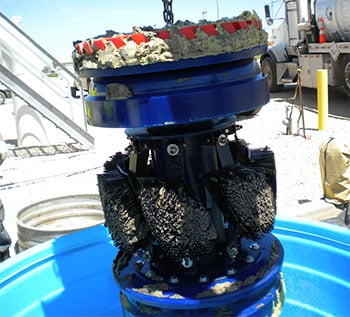Crude oil and gas condensates contain varying amounts of wax or paraffin. When oil is at 60 to 70°c, the wax is dissolved, but as the temperature drops below 35–40°C, wax solidifies onto the walls of the pipe, causing roughness, turbulent flow and diameter restriction that reduces product flow. The wax can become extremely hard on the wall of the pipe through time, especially with static flow and temperature changes during maintenance shutdowns.


Although regular pigging maintenance program prevents the potential for wax and paraffin to form, flow is maximized and energy costs reduced, it is critical to use the right pigs and pigging method to avoid damage to check valves.
Inline Services offers pipeline cleaning pigs specifically made to effectively remove wax from the line by keeping it suspended in the product flow ahead of the pig. Keeping the wax ahead of the pig is key to avoiding damage to valves.
27731 Commercial Park Road
Tomball, Texas 77375
Tel: +1 -281.401.8142
Toll-Free: +1 -888.973.0079
Fax: +1 -281.401.8147
Simple Pigging System with Drop-Out
Simple Pigging System Closure
This animation demonstrates a simple pigging system closure. Inline’s VIPRS pig is positioned in the launcher as the product is run through the pipeline. At the end of the product run, the VIPRS pig is launched to remove all product from the line. The pig will trigger the indicator to alert that the pig has reached the end of the line.
Bi-Directional Pigging
This animation demonstrates Bi Directional Pigging. Inline’s VIPRS pig positioned in the launcher as product is run through the pipeline. At the end of the product run, the VIPRS pig is launched to remove all product from the line. When the VIPRS pig reaches the JB receiver, the propelling media is turned-off. When this happens the VIPRS pig is resting at the jail bar in the JB receiver; propellant is used on the receiver side of the pig to return it to the launcher.
Automated CIP System
This animation demonstrates a fully automated VIPRS bi directional pigging process system with CIP. Inline’s VIPRS pig is first positioned in the pig launcher. The product is pumped from the storage tank to the destination. The VIPRS pig is then launched to push the remaining product to the destination and captured in the VIPRS wash chamber at the destination station. Next, the CIP solution is pumped through the line to wash the chamber and pig. Finally, the pig pushes the CIP solution out of the piping and leaving the pig clean and ready for the next product run.